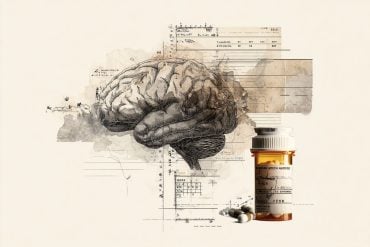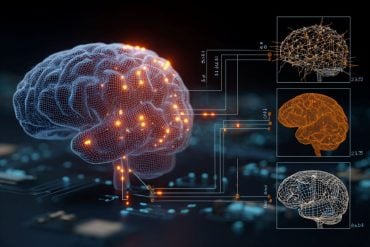Summary: Combining neuroimaging data with machine learning, researchers have identified patterns of brain activation during reward anticipation, associated with an increased risk of developing bipolar disorder. The patterns of neural activation predict the severity of mania symptoms in young adults who have not yet developed the disorder.
Source: Elsevier
Patterns of brain activation during reward anticipation may help identify people most at risk for developing bipolar spectrum disorders (BPSD), according to a study in Biological Psychiatry: Cognitive Neuroscience and Neuroimaging. Mania in people with BPSD is often accompanied by impulsivity, including impulsive responses to potential rewards. In the study, patterns of neural activation during a reward task predicted the severity of the mania symptom in young adults who have not yet developed the disorder.
“Given that emerging manic symptoms predispose to bipolar disorders, these findings can provide neural biomarkers to aid early identification of bipolar disorder risk in young adults,” said first author Leticia de Oliveira, PhD, Federal Fluminense University, Brazil.
Having a family member with BPSD puts a person at risk for the disorder, but the relationship doesn’t provide enough information to make decisions about potential interventions to help delay or prevent the disorder. The new study shows for the first time that brain activation patterns could be used to predict BPSD risk on an individual level. “These findings could be potentially used to guide the development and choice of early therapeutic interventions, reducing the significant social costs and deleterious outcomes associated with the disorder in these vulnerable individuals,” said Dr. Oliveira.
To be sure that the approach would apply to anyone at risk, Dr. Oliveira and colleagues performed the brain imaging in a transdiagnostic group of young adults–the participants had a variety of psychiatric complications, but none had yet developed BPSD.

Of the whole brain, activation in a brain region used during decision making in reward contexts called the ventrolateral prefrontal cortex (vlPFC), contributed the most to the prediction of symptom severity. This suggests that vlPFC activity, in particular, may be useful to predict the severity of mania symptoms associated with BPSD risk in young adults.
“This study shows how the powerful combination of computational image analysis tools and functionally targeted task fMRI (in this case reward processing) can provide insights into the neural systems underlying symptoms that may indicate liability to mania, in a young, non-bipolar transdiagnostic group of psychiatric patients,” said Cameron Carter, MD, Editor of Biological Psychiatry: Cognitive Neuroscience and Neuroimaging.
The researchers replicated the results and the role of the vlPFC in a second independent sample of young adults in the same study, further confirming the potential utility of neural activation in this brain region as a biomarker for BPSD risk.
Source:
Elsevier
Media Contacts:
Rhiannon Bugno – Elsevier
Image Source:
The image is in the public domain.
Original Research: Open access
“Predicting Bipolar Disorder Risk Factors in Distressed Young Adults From Patterns of Brain Activation to Reward: A Machine Learning Approach”. Leticia de Oliveira et al.
Biological Psychiatry: Cognitive Neuroscience and Neuroimaging. doi:10.1016/j.bpsc.2019.04.005
Abstract
Predicting Bipolar Disorder Risk Factors in Distressed Young Adults From Patterns of Brain Activation to Reward: A Machine Learning Approach
Background
The aim of this study was to apply multivariate pattern recognition to predict the severity of behavioral traits and symptoms associated with risk for bipolar spectrum disorder from patterns of whole-brain activation during reward expectancy to facilitate the identification of individual-level neural biomarkers of bipolar disorder risk.
Methods
We acquired functional neuroimaging data from two independent samples of transdiagnostically recruited adults (18–25 years of age; n = 56, mean age 21.9 ± 2.2 years, 42 women; n = 36, mean age 21.2 ± 2.2 years, 24 women) during reward expectancy task performance. Pattern recognition model performance in each sample was measured using correlation and mean squared error between actual and whole-brain activation–predicted scores on behavioral traits and symptoms.
Results
In the first sample, the model significantly predicted severity of a specific hypo/mania-related symptom, heightened energy, measured by the energy manic subdomain of the Mood Spectrum Structured Interviews (r = .42, p = .001; mean squared error = 9.93, p = .001). The region with the highest contribution to the model was the left ventrolateral prefrontal cortex. Results were confirmed in the second sample (r = .33, p = .01; mean squared error = 8.61, p = .01), in which the severity of this symptom was predicted using a bilateral ventrolateral prefrontal cortical mask (r = .33, p = .009, mean squared error = 9.37, p = .04).
Conclusions
The severity of a specific hypo/mania-related symptom was predicted from patterns of whole-brain activation in two independent samples. Given that emerging manic symptoms predispose to bipolar disorders, these findings could provide neural biomarkers to aid early identification of individual-level bipolar disorder risk in young adults.






